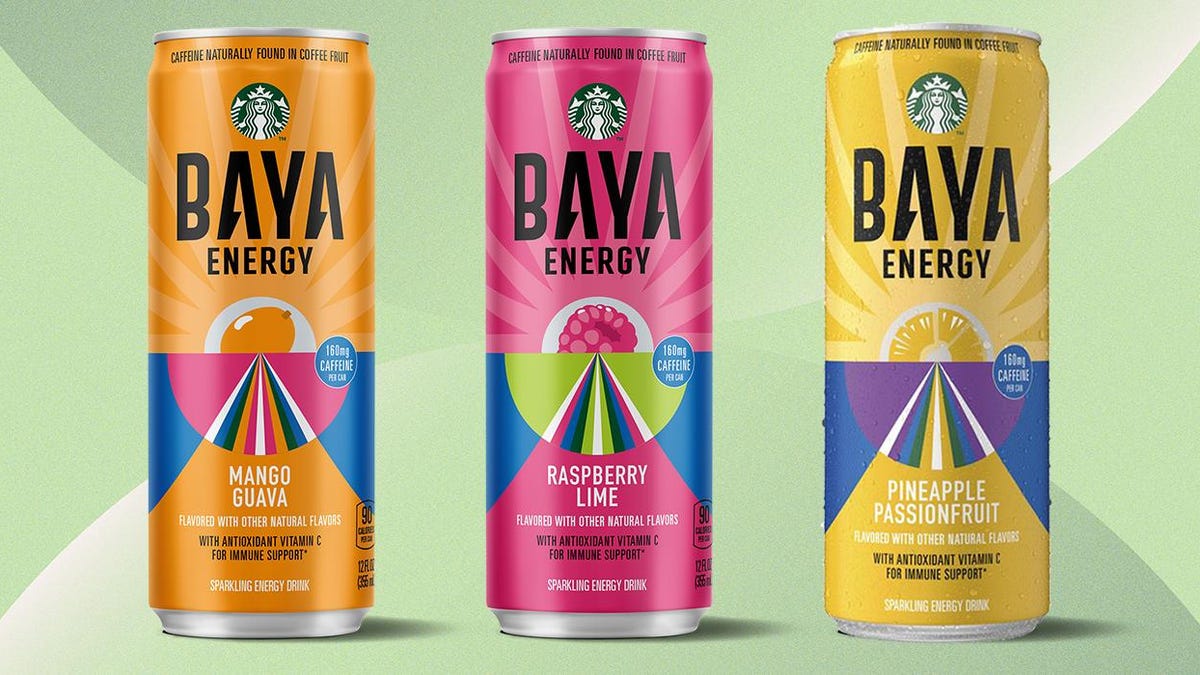Starbucks Baya Energy drink: What's in it and where to get it
The new energy drink from Starbucks comes in three fruit flavors.

Starbucks new Baya Energy comes in mango guava, raspberry lime, and pineapple passionfruit
Feeling low on energy? Starbucks wants to give you a boost. The coffee-maker's new Baya Energy line is a range of fruit-flavored drinks that gets it caffeine boost from the coffee berry.
Available in supermarkets and convenience stores, Baya Energy comes in three flavors: Raspberry Lime, Mango Guava and Pineapple Passionfruit.
Here's what's in Baya Energy, where to find it and what else Starbucks is rolling out in 2022.
For more, find out about Starbucks' cashier-free coffee shop, the perks of Japanese-style iced coffee and how to clean your Keurig coffee maker.
How does Baya Energy stack up against other caffeinated drinks?
The new offering could appeal if you're looking for a buzz with less bloat: A 12-ounce can of Baya Energy has 160 milligrams of caffeine, compared to 180 mg in the same size can of RockStar Original Energy Drink. But it has just 90 calories, compared to RockStar's 200 calories.
A 12-ounce black coffee from Starbucks, meanwhile, contains 193 mg of caffeine and just 4 calories.
Rather than guarana or ginseng, Baya gets its caffeine pick-me-up from coffee berries and beans and also includes 90 mg of vitamin C.
All three flavors contain carbonated water, white grape juice concentrate, beta carotene, green coffee bean extract and about 22 grams of cane sugar, which is responsible for most of their calories.
Where can I find Starbucks Baya Energy?
Starting this week, Starbucks Baya Energy is available across the US in grocery stores, convenience stores, gas stations and through online retailers. It'll cost $3.
Baya Energy will also be sold at Starbucks coffee shops in the US beginning March 1.
Each can of Baya has 160 mg of caffeine and 90 calories.
How big is the energy drink market?
Starbucks has infused its Doubleshot espresso line with guarana and ginseng -- stimulants also found in Monster, Red Bull and other energy drinks -- but this is the Seattle-based company's first true foray into the global energy drink market, which topped $61 million in 2020 and is expected to approach $100 billion by 2027, according to Brand Essence Market Research.
"We have always listened to customers and kept an eye on emerging trends to determine what to create next," Chanda Beppu, vice president of Americas channel development at Starbucks, told CNN. "Most recently, we've seen a steady increase in energy drink consumption."
The Baya Energy brand was developed through the North American Coffee Partnership, a longstanding joint venture between Starbucks and PepsiCo, which already owns Mountain Dew Amp, No Fear and Rockstar energy drinks.
Starbucks is making more readymade drinks
The coffee giant isn't putting all its beans in one basket: It introduced several other new ready-to-drink products that will arrive in stores throughout the year, including its first Frappuccino coffee drinks made with oat milk.
Following the introduction of oat milk in Starbucks cafes in 2021, the non-dairy beverages will come in two flavors -- caramel waffle cookie and dark chocolate brownie.
A new dark-chocolate version of Starbucks' popular premade Cold Brew coffee is also made with oat milk and available in stores now.

